History of Hill Hook Nature Reserve
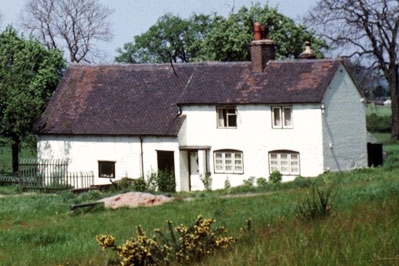
Credit: K Williams
Hill Hook Local Nature Reserve is located in Four Oaks, Sutton Coldfield, Birmingham, nestling between Hill Hook Road and Clarence Road not far from Sutton Park. This hidden oasis of green is bordered by residential streets and Aston Wood Golf Club.
The large pool originally provided water to Hill Hook Corn Mill, which operated from the 1600's. The mill pool now provides the focal point for the 7.5 hectares Local Nature Reserve, which also comprises an extensive area of woodland and rough grassland providing habitat for a wide variety of trees, plants and animals including, bats, butterflies, moths, birds, fish and small mammals.
The settlement at Hill Hook was probably established between 1530 and 1580. The 17th century date for the establishment of the mill at Hill Hook makes it a relative latecomer to the area. The stream was dammed to form the mill pool, this was necessary as the water supply was poor so near to the source. A lower position downstream would have guaranteed a better supply, but this would have taken it outside the control of Sutton Coldfield. The Hill Hook Mill was the most northerly of Sutton Coldfield mills. The over flow from the mill pool runs into the Footherley Brook which flows north to Shenstone and then east to the River Tame at Tamworth in Staffordshire.
The original mill pool was only half its present size so the millers must have experienced considerable difficulties keeping the mill working with such a small reserve of water during times of drought. To start with the water wheel stood outside the mill and was open to the elements. The mill at Hill Hook was always of modest size and was unlikely to have attracted a sufficient volume of business to earn a living through milling alone. Farming would have provided an additional source of income and subsistence.
Hill Hook Mill operated for many years grinding corn for local residents and farmers. The first record of a miller at Hill Hook was that of Oliver Cartwright in 1671. The next known miller was Edward Dickman who died in 1676. At this time William Bickley took over the mill, he was the first of a long line of Bickley's, who were to occupy the mill for the next 157 years. William Bickley made a will on the 26th October 1683 as he lay dying. It was stated that he was weak in body but of good sound and perfect memory. He described himself as a Wheel Maker. William Bickley died in February 1684. He had four children, William, John, Elizabeth and Frances. On William Bickley's death an inventory of his holding was made, which included one cow, two heifers, two calves, one old mare, two colts and one little store pig. William Bickley's possessions added up to a total of £17-14-6d. John Bickley took over the running of the mill after his father's death. When John Bickley died in July 1706 his inventory included three horses and fifteen sheep. His possessions added up to a total of £18-3-4d.
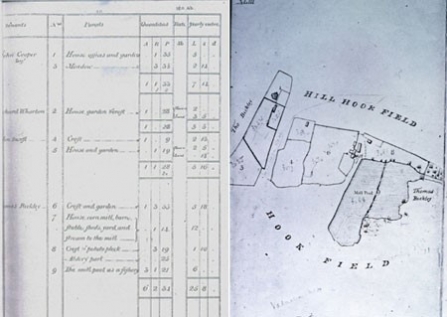
Credit: Friends of HHLNR
Simon Bickley was the next miller at Hill Hook. In 1713 he was in trouble with the landlords of the mill. At this time the rent for the mill pool was 2 shillings per year, plus a dish of fish whenever the pool was fished. With so many pools in Sutton the Warden and the Society were surely ensuring themselves of a steady supply of fish throughout the year.
John Bickley was the next miller at Hill Hook, he took over in 1720. John Lunn, the 'Overseer of the Poor' for Hill and Little Sutton, recorded his expenses in 1734 as "looking for the Miller, father of widow Whites bastard child, 3 shillings." In 1724 John Bickley was again in trouble with the Warden and Society and was fined 6d.
The expansion of small farms and cottages with their fields around Hill Hook may have been the stimulus for enlarging the mill pool. In 1767 Simon Bickley was given permission, by the Warden and Society of Sutton to enlarge the mill pool by enclosing part of the Hill Hook field, for which an extra shilling rent was payable. Simon Bickley was fined in 1774 for enclosing a parcel of land adjacent to the mill pool. In the following year he was fined 4d for enclosing another parcel of land by the mill pool. In 1786 the miller at Hill Hook was listed as Thomas Bickley.
A Survey of Warwickshire, which was completed in 1789 by Will Yates & Sons, lists 8 water mills in Sutton Coldfield:
Hill Hook Mill - Corn.
Park House Mill - Blades.
Longmoor Mill - Corn, Leather & Buttons.
Powell's Mill - Spades & Metal Rollings.
Oughton's Mill - Gun Barrels & Bayonets.
Newhall Mill - Corn.
Penns Mill - Wire, Fulling & Blades
Plants Mill - Wire & Forges.
The next miller at Hill Hook was Thomas Bickley. His rent was £1-1-0. There is no record of a request to provide a dish of fish for the Warden and the Society. The last reference to provide a dish of fish to the Warden and the Society was in 1742.
In 1797 young John Bickley was riding his horse during a thunderstorm when both were struck by lightning and killed. A plaque commemorating this tragedy is fixed to the front of the flats on Clarence Road, opposite Hill Hook Road.
In 1811 a Survey, Plans and Valuation of the Charity Estates belonging to the Warden and Society was carried out. This Survey shows that Thomas Bickley was still the tenant of Hill Hook Mill at the time. The map shows the mill, house and various outbuildings. It also shows the line of the original dam with trees growing on the dam. It can be seen from the records what Thomas Bickley rented other holdings at Hill Hook, including:
Area Rent
Croft and garden. £5-18-0
House, Corn Mill, Barn,
Stable, sheds, Yard and Strean to the Mill. £12-0-0
Croft and Potato Pleck. £1-10-0
Alderly Part.
The Mill Pool as a Fishery. £6-0-0
Total
£25-8-0
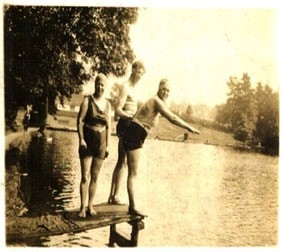
Credit: Friends of HHLNR
In an inventory of 1815 it was recorded that there was a pair of Derbyshire millstones and a pair of French Burr millstones. The French Burr millstones were used for grinding wheat and fine grade flour.
Thomas Bickley was again in trouble with the Warden and Society in July 1817, having cut down a number of trees without their permission. He was the last of the Bickley millers and figures prominently in the records of a lengthy dispute with the Warden and Society over the ownership of the mill. The Warden and Society rejected Thomas Bickley's offer of three houses in exchange for the mill. In 1831 the annual rent was raised to £25. In 1834 Thomas Bickley left and his goods were sold off to account for his rent arrears. The list of items sold included: one rick of hay, two horses, one cart, four pairs of bedsteads, four beds, bedclothes, one clock, four tables, one dresser and shelves. It was noted that W. Willoughby received £4 from the sale of Thomas Bickley's goods.
The water wheel is described as being in a "deplorable state of dilapidation" and the mill house and buildings similarly in "a wretched state of neglect and decay". Speedy repairs were recommended to prevent them falling to the ground!
The next miller at Hill Hook was John Hipkinson. He occupied the mill from 1834 to 1837.
In the Census of 1851 John Stevenson was recorded as the miller at Hill Hook and he also farmed 14 acres. He was born in Nottingham and his wife Elizabeth who was 53 years old was born in Weeford in Staffordshire. The Stevenson household also included Isabella Piper their 18 year old niece who was born in Bridgnorth in Staffordshire and another niece Catherine Till who was 23 years old. The two nieces were employed as House Servants. The last member of the Stevenson household was William Earp who was 18 years old and was born in Sutton Coldfield. He was employed as a Servant and labourer. Around this time major alterations had taken place at the mill. This can be seen by the differences between the Corn Rent Map of 1824 and the Enclosure Map of 1851.
Further repairs to the mill took place in 1856, 1861 and 1889. The cost of repair in 1861 totalled £65-7-9d. Municipal Charities were now the new owners of the mill.
In 1861 Thomas Marshall was the miller at Hill Hook, he stayed until 1896. He lived at the mill with his wife and an employee George Ashford who was also described as a miller. Austin Pinfold was the next miller at Hill Hook, but he only stayed a short time. His possessions were put up for sale. A notice was inserted in the "Sutton and Erdington Times" for the sale on Wednesday the 23rd of March 1898. The list of item for sale included: Farm implements, live and dead farming stock, household furniture, two excellent fishing punts, with anchors and oars. Both Thomas Marshall and Austin Pinfold described themselves as millers and farmers. They also gave the address as Marlpit Farm, Hill Hook.
The next tenant at Hill Hook was George Goldsby who was the first tenant to describe himself as a farmer not a miller. George Goldsby, who was 66 years old, took over the tenancy of Hill Hook on the 26 March 1898. His tenancy included the marl pit which had been dug near the mill by 1800, and had been neglected for some time. The marl pit was just off Hill Hook Road, which is now Bradgate Drive. George Goldsby had to put and keep the marl pit in good repair subject to the right of the local inhabitants to take marl from the pit. Owners and occupiers on Long Lane, now Clarence Road, had the right to take water from the springs that fed the marl pit. George Goldsby was a farmer from Four Oaks and was involved in hiring out large marquees for country fairs. He was born in 1832 and his wife Harriet was born in 1834 they are thought to have had 13 children:
Ada Elizabeth who emigrated to America and married Mr Jenkins.
Edith - married Henry Bracebridge who was the next tenant.
Kate - married Mr Harley.
Rachel - married Mr Purcell.
Jane - married Mr Welland.
William - unknown
Jessie - married Mr Pountain.
Sarah - married Mr Nash.
Phoebe - unknown
Mary and Emma who were twins. Mary emigrated to America and married Mr Fahey.
George Goldsby only lasted 2 years at the mill and died in 1900. His wife stayed on until her death at the age of 71 on the 18th December 1905. Both are buried at St Peters Church in Little Aston. Their daughter Edith married Henry Bracebridge, who was the next tenant at Hill Hook. The Mill Pool at this time provided the power for the mill and was used for various activities such as fishing and boating.
On 13th of July 1911, an excursion party from the firm Scribbans Bakers & Confectioners, from Hockley, Birmingham, were spending a day at Hill Hook Mill. Two young men from the party were in a boat, one lost an oar. He leaned over and the boat filled with water and sank. One of the two men managed to swim to the side of the mill pool. The other, Dick Smith, went under the water and was rescued by Joseph Smith. Stephen Bracebridge the miller at the time successfully applied artificial respiration to Dick Smith.
One of the Directors of Scribbans Bakers & Confectioners, Mr Harry Scribbans later bought Little Aston Hall in 1925 with 118 acres of land.
Stephen Bracebridge was born in Little Bromwich & enlisted in 1916 at the age of 35. He was sadly wounded in action and died in Rouen, France in 1918. His wife Edith and his two children, Kathleen and Neville stopped on at the mill at a reduced rent. In his army records he listed his profession as a "caterer" not a miller.
In 1919 the lease for Hill Hook Mill was then sold to a Mr Holt of Blake Street along with Hill Hook Farm. Buy this time the rent was £60 per year. Repair work was carried out in 1921, 1925 & 1926. At this time the mill had ceased to function and these repairs were made only to the fabric of the building.
The local train station at Blake Street was opened in 1884 and was used to bring in children & adults to Hill Hook. By the First World War Hill Hook Mill was already well known to many Sutton and Birmingham people as a popular destination for Sunday School outings etc. Fishing, boating and skating, when the pool was frozen over, would be enjoyed by all. A small amusement park was located on the field overlooking the mill pool. There were swings, roundabouts and an old railway carriage and other buildings where afternoon tea was served to the visitors. The mill pool was also used by fishermen and was well stocked with pike. Mr Joseph Smith looked after the amusements and the fishing in 1925.
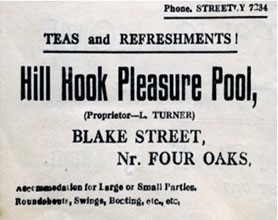
Credit: Friends of HHLNR
In 1926 William Taylor, the current tenant, made a request to Municipal Charities for permission to use a mechanical organ with a roundabout on the site. According to Kelly's Directory, William Taylor ran refreshment rooms at the mill. He was not concerned with milling or farming. A request was made to discontinue the use of the steam whistle on the roundabout and the use of the mechanical organ did not please everyone, local residents complained to Municipal Charities about it.
The next tenants at the Hill Hook Mill were Mr Turner, Mr Carter and Major Poole. By this time most of the amusements were not in use and had been abandoned.
The mill was unoccupied during the Second World War. It was not until 1946 that newly married tenants, Mr & Mrs Harrison moved in. They stayed until 1952. The machinery cellar was inaccessible and the water wheel in too dilapidated a condition to do more than half a turn. An attempt was made to cultivate the adjoining land, during which some remains of the swings and roundabouts were uncovered. Local fishermen still used the mill pool and enjoyed the mugs of tea that Mrs Harrison made.
On the 10th April 1957 Hill Hook Mill and some nearby land was sold at auction to Cincinatte Milling Machines Ltd. a Birmingham Company, for £5,400. The land sold at auction by Municipal Charities totalled 22.9 acres. It was stated in the auction documents that "Notice has been served upon the vendors by Sutton Coldfield Corporation notifying the vendors that it is proposed to consider the making of a Demolition Order upon the said message or dwelling house and outbuilding known as Hill Hook Mill, and the purchaser is deemed to purchase with full knowledge of this notice and its effects."
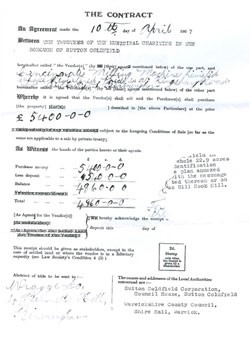
Credit: Friends of HHLNR
The Company installed Mr Medlam as a caretaker and he was the last tenant ever to reside at the mill. He was forced to leave in 1968 due to ill health. The empty mill then became prone to vandalism.
Mr Norman Evans visited the site in July 1970 and recorded that the machinery and the single pair of millstones were still intact. Vandals then set fire to the mill causing the floor to collapse and the millstones to crash into the cellar below. Sadly the Hill Hook Mill was demolished towards the end of 1970.

Credit: K Williams
Mr David Higgs, a Streetly builder, salvaged two mill stones and a large oak beam. One of the millstones was used to form steps to a house in Streetly Road, Sutton Coldfield, the other millstone was used as part of a fireplace and the oak beam to span the living room in a bungalow in Four Oaks.
By 1979 the dam was badly neglected and so the water in the mill pool was allowed to run out, revealing a heavily silted bed. The empty pool revealed the original gravel dam. Only the top part of the waterwheel was above ground level and this had been vandalised.
The Birmingham City Council purchased the land from Cincinatte Milling Machines Ltd in 1980 to establish a public open space and nature reserve. In late 1982 Birmingham City Engineers Department drew the attention of Birmingham and Warwickshire Archaeological Society to a mill wheel buried in situ at Hill Hook. It was threatened by plans to strengthen the mill pool dam and to improve the outflow channel. A Manpower Services Commission scheme was agreed, which involved the excavation of the water wheel pit and also the adjacent machinery cellar. Work began in January 1983 and lasted for two months. The site was backfilled and partly covered by the new outflow structure. The cellar walls were capped and a small garden planted. The scheme also included the de-silting of the pool and repair of the dam at a cost of nearly £60,000. During de-silting the old dam was totally uncovered. Only two small central sections now remain which are the two islands we see today.
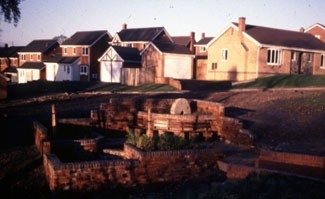
Credit: Friends of HHLNR
Sutton and Birmingham Archaeological Societies started to excavate the site in October 1982. The team was lead by Mike Hodder and George Demodowicz. The water wheel was taken away for restoration and was then installed at Forge Mill in Sandwell Valley. The cellar was cleared of rubble and the cast iron wallower and parts of the sack hoist were found. The steps down to the cellar were made out of old Derbyshire millstones and a single French burr millstone was found set in the floor of the cellar. Other old Derbyshire Peak millstones were used in the construction of the old bridge. It was hoped that the Derbyshire Peak millstone would be preserved and displayed on the site but they were broken up when the new bridge was built. Only one repaired millstone is left and can be found displayed in the formal garden covering the old mill. Looking at the brickwork in the cellar and the wheel pit it was noted that many alterations, repairs and changes had take place over the years.
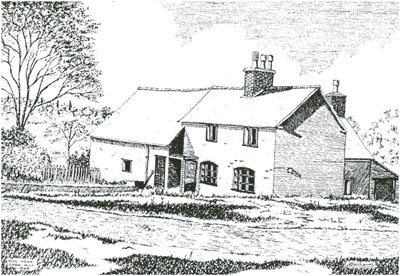
Credit: Kenneth Williams
By March 1984 repairs to the dam had been completed and the mill pool re-filled. All that was left of the original dam were two small islands. The cellar and the wheel pit were filled in and the walls capped to mark the site.
In 1985 Mr K Williams completed his research into the history of "Hill Hook Water Corn Mill". He produced a detailed account of the history of the mill along with a number of fine pen and ink drawings.
Hill Hook site was declared a Site of Importance for Nature Conservation (SINC) in 1990 and became a Local Nature Reserve in 2003. The Hill Hook Local Nature Reserve Advisory Committee was formed in 2003, running events funded mainly by Birmingham City Council and Sutton Coldfield Ward. Funding was also obtained from Sutton Coldfield Municipal Charities, South Staffordshire Water and The Co-op. At the present time the Hill Hook Local Nature Reserve Advisory Committee is planning to become part of The Birmingham and the Black Country Wild Life Trust. The Advisory Committee has moved forward from the original aims and will become 'Friends of Hill Hook Local Nature Reserve'.
In recent years local volunteers have been actively involved in improving the reserve which now attracts visitors from a broad cross section of the local community. Regular events, involving The Birmingham and the Black Country Wildlife Trust, are organised to provide opportunities for everyone to experience the wide diversity of the site.
Some local residents can remember the mill at Hill Hook and it's pleasing to see them enjoying the site and talking about their memories.
It is a shame that in the late 1960's an opportunity was missed to preserve Hill Hook Mill which could have enjoyed a renewed lease of life as a working corn mill to be enjoyed by the local community and visitors to the area, however we must be thankful for what we have now, 7.5 hectares of Local Nature Reserve as a lasting legacy left by the millers of Hill Hook.
This history has been researched and written by ... ...
